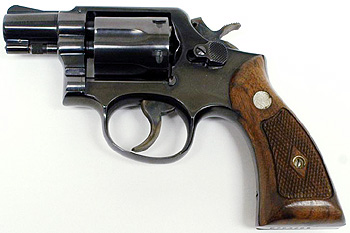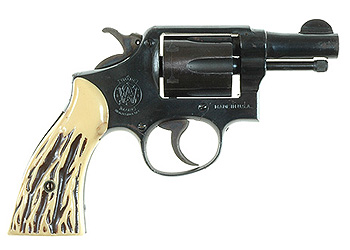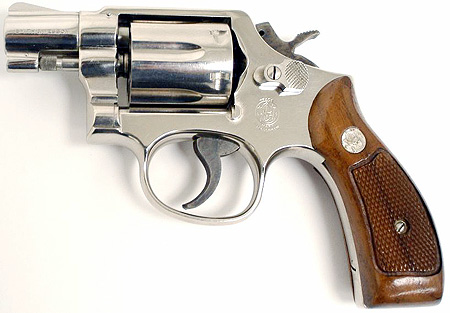 The very first handgun I ever fired was an old Smith & Wesson Military & Police .38 Special with a 4 barrel. Im sure a lot of others cut their handgun teeth on the M&P as well. It is rugged and reliable, and the old ones, sometimes referred to as long stroke, have one of the best DA triggers of the class. I didnt know any history about it except that it was really old, but what struck me was that I hit the pop can I was aiming at with the first shot. It left a lasting and positive impression on my young mind. The M&P still ranks as one of the most popular handguns ever built. It is known variously as the Military & Police, the Victory Model (during WWII) and the Model 10.
The very first handgun I ever fired was an old Smith & Wesson Military & Police .38 Special with a 4 barrel. Im sure a lot of others cut their handgun teeth on the M&P as well. It is rugged and reliable, and the old ones, sometimes referred to as long stroke, have one of the best DA triggers of the class. I didnt know any history about it except that it was really old, but what struck me was that I hit the pop can I was aiming at with the first shot. It left a lasting and positive impression on my young mind. The M&P still ranks as one of the most popular handguns ever built. It is known variously as the Military & Police, the Victory Model (during WWII) and the Model 10.
Initially introduced in 1899, the Military & Police is the first K-frame revolver from Smith & Wesson. It holds six rounds of .38 Special or .38/200 in the British Lend-Lease version of the Victory Model. It is slightly larger than the J-frame and a bit smaller than the L-frame. The K-frame has been the most successful frame size in Smith & Wessons history (although the J-frame is probably eclipsing it now). The K-frames were designed from the beginning as service sidearms for people who had to carry guns a lot. It was big enough but not too big, once described as Just enough of everything. Wheelgun fans will often say that they carry a J-frame mostly, but if you ask their favorite wheelgun, it will quite often be one of the many K-frames that S&W has produced over the years such as the models 10, 19 and 66.

The M&P didnt begin its life as a snubnose. S&W maintained their bias toward long barrels on .38 Specials for many years, even after Colt brought out the Detective Special in 1927 (and even after S&W sold a boat load of .32 caliber Terriers in snubnose size). The first production snubs in the M&P family were 2 barreled Victory models built in WWII between 1942 and 1945. (If anyone knows of an earlier M&P snubnose, let me know.) The 2 barrel Victory Models are very scarce. It is also known that approximately 300 snubnose Victory models were transferred to the Justice Department.
The snubnose M&P (also referred to as the pre-Model 10) went into regular commercial production circa 1946. It was produced in both nickel and blued steel finishes. Beginning in 1952, an Airweight version, later to be known as the Model 12, was begun. It, like the Aircrewman revolver, was all aluminum alloy in the beginning. Due to cylinder cracks, the cylinder was changed to steel in 1954. The all-aluminum alloy Airweights with alloy cylinders should not be fired, even with normal power ammunition. If you send one to Smith & Wesson for repair, it will return with a steel cylinder. In a similar fashion, the Air Force destroyed most of the Aircrewman all-alloy revolvers and surviving specimens are very rare and unsafe to fire.
The Model 10 is very safe to fire and there are many still in service today. It is heavier and larger than the J-frame snubbies, making it somewhat less comfortable for concealed carry, but it does hold one more round than the J-frame and many find the additional weight appealing for shooting. Many knowledgeable handgunners will tell you that the Model 10 remains one of the best values and best picks for ease of operation and ruggedness in the handgun market today.


Comments, suggestions, contributions? Contact me here